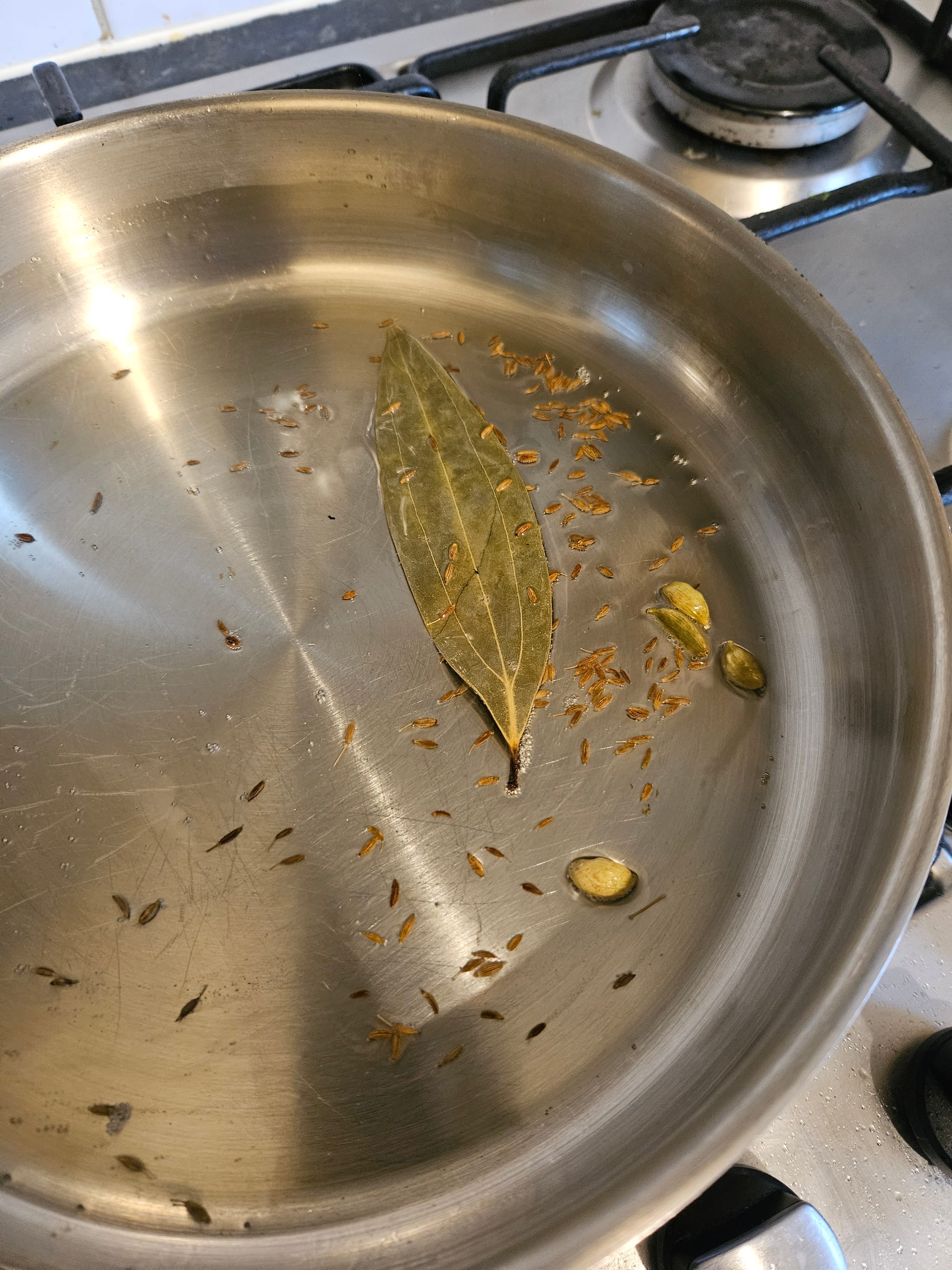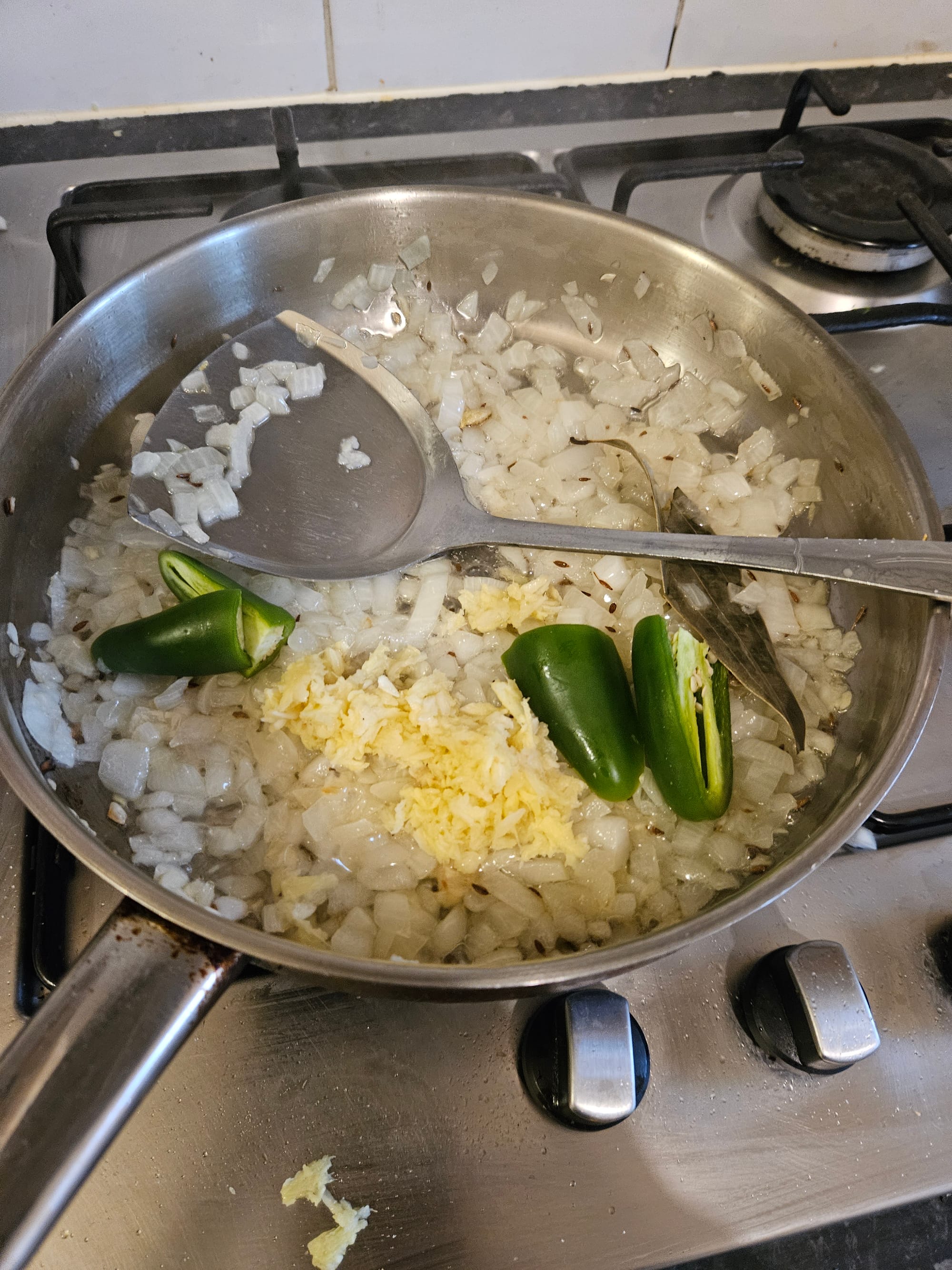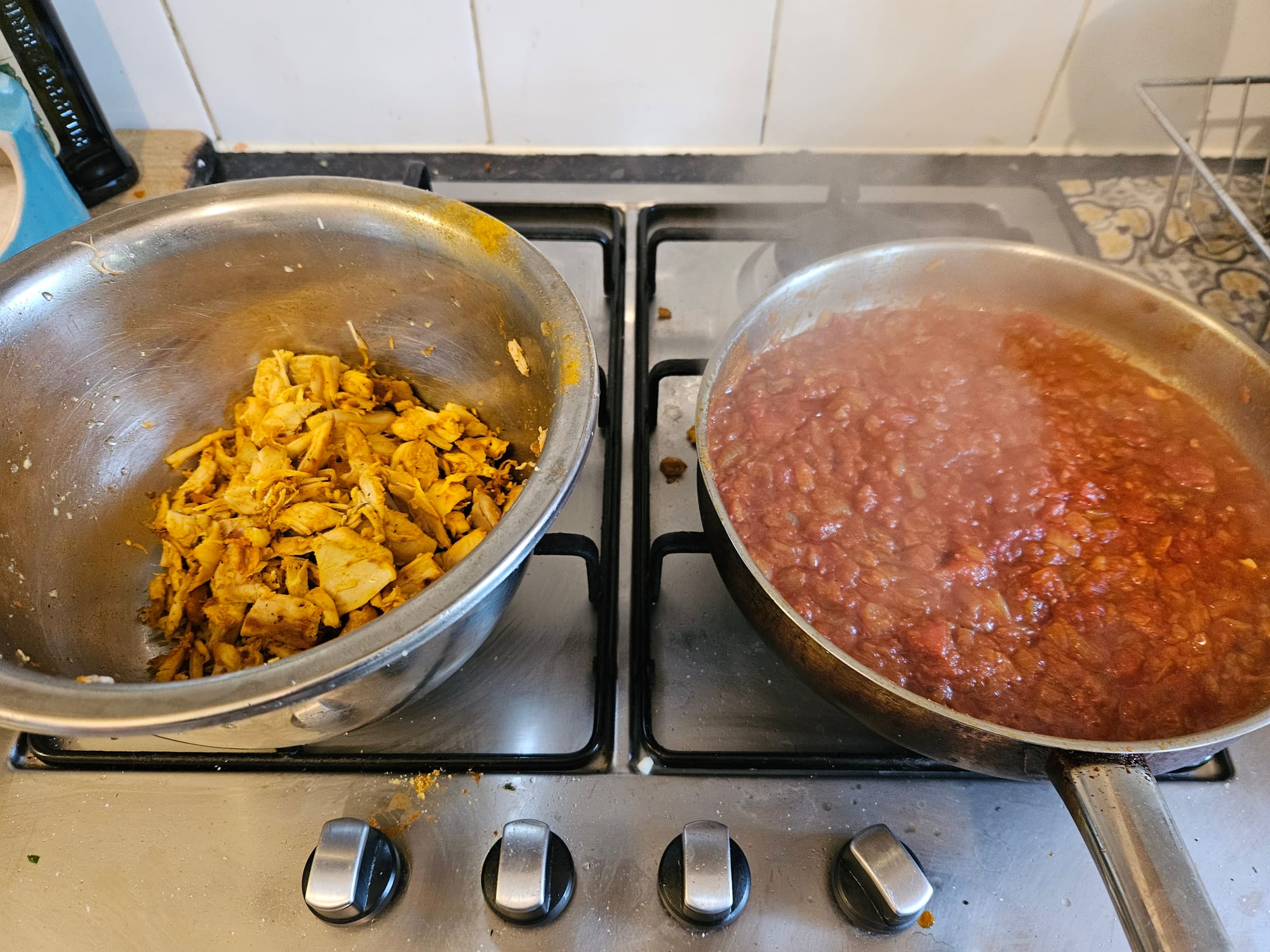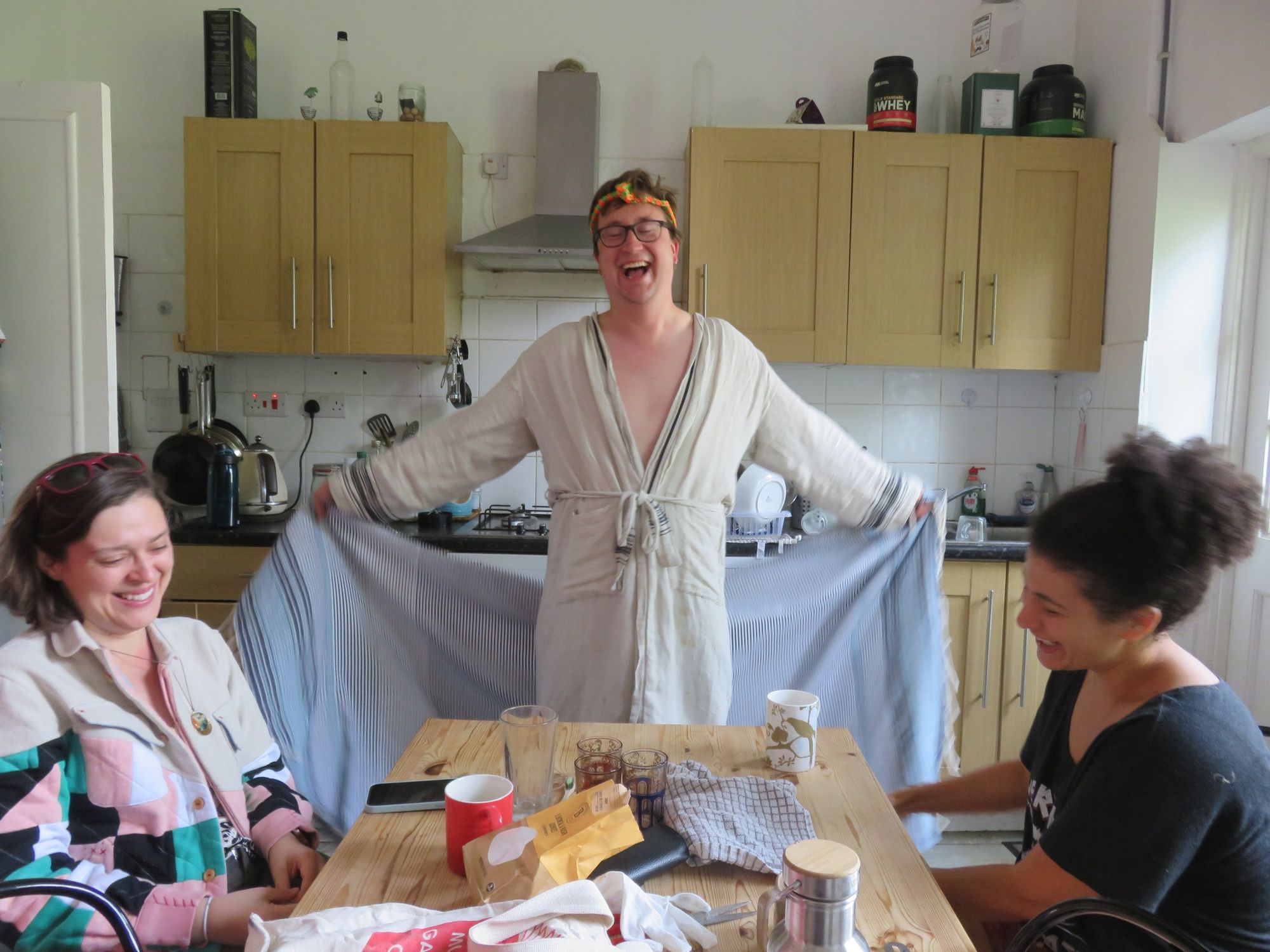Butter Chicken Tikka Masala Archaeology
What’s the difference between Chicken Tikka Masala and Butter Chicken? Answering this question has driven me insane. I didn’t even know about butter chicken before moving to the UK — all of the Indian restaurants I’d encountered in the States only had C.T.M. on the menu — and I had assumed both were traditional dishes with a long pedigree. And the sauce or spice was different, or something. Oh, how wrong, how foolish I was.
In preparation for this dispatch, I have downloaded two books of culinary history, found a dozen articles about diaspora community food culture, read through court filings of an ongoing trademark dispute, researched Hindi etymology, studied restaurant facilities and technology in post-partition Delhi, phoned a series of Indian restaurants here in London, and, of course, prepared a dish. I still cannot tell you which one I cooked.
Let’s cover the similarities. Chunks of chicken, marinated in yogurt and spices, are grilled or roasted and then served in a tomato-y spice-y sauce. Neither, however, is a traditional dish at all. Both were apparently invented in the 20th century by canny restaurateurs. Both have entirely non-standardized recipes: no two chefs can agree on what exactly constitutes either dish. Both will inspire arguments that one contains or lacks onions, dried fenugreek leaves, butter, cream, cashews, chilies. I found one chef who claimed that at his curry house, the only difference between the butter chicken and the chicken tikka masala was which cut of chicken they used.
Ok. Let’s do our best to do a bit of re-constructive culinary archeology.
—
We start our story in Punjab, modern-day Pakistan, where countless village women for millenia have brought their wheat flour dough down to the community tandoor, a big clay oven dug into the earth, to bake. It seems like a waste of heat to just let it go out after all the baking is done, so sometimes they would drop a whole chicken down there, too. Sometimes they’d cut up the chicken into “tikka” — little bits, in Persian — and thread them on skewers before lowering them into the oven’s mouth. Thousands-year-old evidence of chicken bones in fossilized tandoors has been uncovered from the Indus River Valley. This is an old, old tradition.
Before independence, there wasn’t really “Indian food” in the aggregate, since “India” is a gigantic, intensely diverse place where climate, language and culture change every 100 miles. There were culinary traditions that women in every region had refined and developed for centuries, but you’d be hard pressed to say any of them had anything in common. There weren’t really “restaurants”, either, where the public could buy cooked food: wealthy zemindars and colonial officials would have had their own well-stocked kitchens and a host of servants to prepare lavish banquets, and everyone else would have cooked food in small communities or at home. The culture of these larger kitchens were adopted into hotels for visiting dignitaries or businessmen.
In waves of pre- and post-Partition migration, men from Punjab crossed the plains and opened roadside restaurants called dhabas that sold only a few items to travellers. At their little stands, they usually only made three dishes, all relying on the same source of tandoori heat: roti, chicken, and sometimes, a rich, buttery dal simmered overnight on the remnants of the coals. Or, alternatively, rather than putting together a portable tandoori, dhaba chefs would just set up a small grill on the roadside, and cook marinated spiced chicken on skewers over the coals.
Three guys from Peshawar in Punjab moved to Delhi in the 1950s and opened Moti Mahal, which was a copy of a place they had in Peshawar, also called Moti Mahal. Moti Mahal popularized the concept of “indian food,” and sit-down “restaurants” that the burgeoning middle-class could visit for a fun or special night out. It was a smash hit. They brought Punjab tandoors to the people and created electric ones so they would be more portable, so other restaurants could start making tandoori food, too. Moti Mahal became a destination. Nixon, Khruschev, Indira Gandhi, Trudeau #1, and Jackie Kennedy all ate there.
Two thirds of the founding guys at Moti Mahal had two thirds of the same name: Kundan Lal Jaggi and Kundan Lal Gujral. The descendents of both Kundan Lals opened their own restaurants in Delhi — one called Daryaganj, named after the neighborhood where the original Moti Mahal was, and the other called (sigh) Moti Mahal, which is in (sigh) Daryaganj. Both restaurants claim to be the inventors of 1) tandoori chicken, 2) dal makhani, and 3) butter chicken.
Based on the history of dhabas, I find it hard to believe that either Kundan Lal "invented" tandoori chicken or dal makhani, since both were widely cooked and sold for years before Moti Mahal. But both restaurants tell the same story about butter chicken, Murgh Makhani in Hindi. As the apocryphal story goes, one of the Kundan Lals had a customer who complained that the chicken was too dry — it had been roasted in the tandoor, but then hanging nearby it all day, getting drier and drier in the smoke. So to reinvigorate it, K.L. whipped up a tasty velvety buttery tomatoey sauce that had been a staple of hotel cooking, makhani gravy, and served the whole thing together. Ta-da: butter chicken.
In the past two years, the owners of Moti Mahal sued Daryaganj for copyright infringement over ownership of the recipes, and the owners of Daryaganj countersued for defamation. Counsel for Moti Mahal says that the defendants are “misleading the public” by trying to associate themselves with the Moti Mahal brand. Counsel for Daryaganj quotes his clients, “They are piggybacking off my legacy. What big cheats they are.” Litigation continues.
Jumping across the sea for the next part of the story: in the 1970s, Bangladeshi and Pakistani people displaced by civil war and economic collapse ended up jobless and immigrated to Britain, and saw an opportunity. They invented what we now know as the “curry house”:
Restaurant owners, often lacking culinary training and resources, turned to tried and tested Anglicised menus from existing restaurants. Poppadoms, onion bhajis, flock wallpaper, pink tablecloths, and waiters in bow ties were institutionalised as British curry house hallmarks from the 1970s onwards, alongside a new menu of curries that de-regionalised existing Indian dishes into an easy to understand (and easy to make) canon that ranked curries according to heat level: korma, tikka masala, jalfrezi, madras, vindaloo.
It all became “curry”. At many of these curry houses, chefs spend the morning making a “master sauce” of onions, tomatoes, garlic, ginger, chilies and spices, and it simmers away on the stove for a good few hours before the place opens. The various curry recipes are customised from the base gravy — adding more onions for a dopiaza, adding more chili for a madras, adding spinach for a saag paneer.
It is far less contentious but no less unknown who exactly invented Chicken Tikka Masala, although everyone seems to agree it was invented in Britain. Supposedly, C.T.M. comes from Shish Mahal in Glasgow. The proprietor, Ahmed Ali Aslam, claimed he got a Scottish customer who growled about the dry leftover grilled chicken he’d received, so Aslam opened a can of tomato soup, added a bit of this and that, and served the chicken in the soup as a composite dish. The apocryphal story, as you might note, strongly resembles our Delhi darling Butter Chicken, and was often retold by Aslam. But it also just as easily could have arisen on Brick Lane, where Sylheti Bangladeshi restaurants would have taken inspiration from the Turkish and Kurdish grillhouses, and doused the chicken in their master sauce plus tomatoes. But it also could have been restaurateurs from Delhi who brought Butter Chicken to Britain and gave it a different name so that it sold better.
Working out the “origin” of a dish is to some extent a completely fruitless endeavor. Food historian Neha Vermani sensibly told the BBC, “nobody can claim to have invented a dish. If food history teaches us anything, it’s that cuisines and dishes are part of an ever-evolving chain of inventions and interventions, built over centuries of not just intellectual labor but the manual labor of unnamed protagonists.” It would be a similarly sensible conclusion to say that both dishes probably are directly descended from a dish created in Punjab generations ago.
Unfortunately, I am not sensible. I want a definitive answer. Here’s my backwards reconstruction and my logic.
Both of these dishes could really only have arisen in a fully-stocked restaurant context. If you’re roasting a chicken in the community tandoor, there isn’t going to be any leftovers: killing and preparing a chicken is reserved for special events in the village. You need to have a surplus of cooked grilled chicken, a lot of stuff on hand for making gravy, and access to both a stovetop and a grill or oven. The fable behind each dish’s creation involving leftovers, a dissatisfied patron, and a clever cook is probably true, in the mythic sense. It seems likely that the play would have been acted out in many different places and different times, leading to multiple chefs inventing it independently. It’s only some of those people that felt compelled to claim the credit.
Next: These dishes must have arisen at different places at different times. Butter Chicken’s name is a direct translation of the Hindi “murgh makhani”. Makhani gravy, as I mentioned, owes its existence to royal and hotel kitchens, and was always on hand. It also has historical pedigree traceable to 1950s Delhi. “Chicken tikka” is the skewered chicken, and the “masala” is the sauce. This does not really make sense as a Hindi name for a dish, because in a vacuum, “chicken tikka masala” to a Hindi speaker would be “the masala spice mix you put on chicken tikka before grilling it”. In subcontinent cooking, the sauce is called “gravy”, not “masala sauce.” The name could only have come from a British context, where immigrants were trying to communicate to their pasty-white customers that there were spices in the tomato soup.
As I said at the outset, neither dish has a standard recipe. I read uncountable recipes from both India and the UK, and watched videos of chefs from all over the world preparing each dish. None of them have anything in common.
In the late 20th century, travel between Britain and India and Pakistan and Bangladesh brought both dishes into contact with each other. Both dishes are now widely available and widely enjoyed in each country. Although each dish in the abstract is defined as a “sweet, rich, tomatoey dish of grilled chicken in a spiced gravy,” when the recipes encountered each other, they had to define themselves by what the other was not. So in each place where that contact happened, each country and indeed each chef made their own calculations based on tradition, preference, customers, trends. Here in Britain for example, I called a few restaurants that listed both dishes on the menu. The consensus among restaurateurs I spoke with seems to be that butter chicken has more spices like fennel and dried fenugreek leaves, spicier, slightly sweeter, and tikka masala is more for curry beginners, it’s not spicy and it’s tomatoey-er and creamier.
My very weird conclusion therefore is that this is less archaeology than evolution. We are not dealing with two individual species with a single divergence on the family tree generations ago. The names we have for these two dishes have been inelegantly applied to a cluster of recipes that arose independently in diaspora, encountered each other through travel and trade, and changed to fit their own own ecological niches, so to speak. There are many butter chickens and chicken tikka masalas. Each of them is authentic.
—
Thank you for bearing with me through my descent into madness. Let’s learn a few key techniques for making a gravy for B.T.C.M.
Temper whole seeds in oil. The kind of oil and the kind of seed determines your region, and is the "nostalgia" level of flavor. Kerala food uses white urad dal, curry leaves and mustard seeds in coconut oil, bengali food uses panch phoran (nigella, cumin, fenugreek, mustard, fennel) in mustard oil, Mughal food uses ghee and cumin and cinnamon stick. Here I used vegetable oil with cumin, cardamom and Indian bay leaf, which together gives it an earthy, cinnamony, herbal kind of aroma.

Next, cook onions. A pinch of baking soda will help them go brown faster. The level of brownness determines the sweetness and depth of flavor. Next: garlic+ginger paste and sliced green chili or dried red chili. Play around with the garlic/ginger ratio.

Next: dry spice powders. You need less than you think. I use a big pinch of turmeric and a small spoonful of chili powder as a base, then customize from there. For a chicken curry you'd want a small spoon of coriander powder to help thicken the sauce and make it stick to the chicken, and then a small spoon garam masala to make it interesting. Fold them gently into the onion mess so they don't burn. Once the oil separates, after a minute or so, it’s cooked. Then, tomato time. Add a swirl of water if needed. Cook until the oil separates, at least half an hour.
At this point you can either blend it all together, or keep it unmushed for a more rustic texture. Both affect flavor in ways that I don’t care about and can’t distinguish. Makhani/Tikka Masala recipes often call for cream or cashew paste to enrich the gravy. Both of these, while delicious, are way too heavy for me personally. I go for yogurt if I’m making more of a north indian dish, or coconut milk if it’s south.

ADD LEFTOVER CHICKEN. I had poached shredded chicken, so to make it more tandoorish, I dusted it with paprika, salt and turmeric, and quickly dry-fried it in a wok.
Your very own Butter Chicken Tikka Masala. Whatever it’s called.
